七年级英语上UNIT 3教案
- 格式:doc
- 大小:85.50 KB
- 文档页数:19
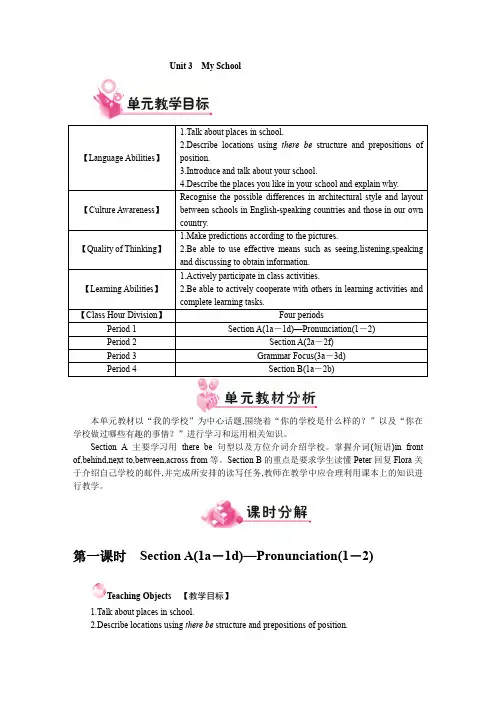
Unit 3My School1.Talk about places in school.Period 4Section B(1a-2b)本单元教材以“我的学校”为中心话题,围绕着“你的学校是什么样的?”以及“你在学校做过哪些有趣的事情?”进行学习和运用相关知识。
Section A主要学习用there be句型以及方位介词介绍学校。
掌握介词(短语)in front of,behind,next to,between,across from等。
Section B的重点是要求学生读懂Peter回复Flora关于介绍自己学校的邮件,并完成所安排的读写任务,教师在教学中应合理利用课本上的知识进行教学。
第一课时Section A(1a-1d)—Pronunciation(1-2)Teaching Objects【教学目标】1.Talk about places in school.2.Describe locations using there be structure and prepositions of position.3.Pronounce /ɔː/,/ɒ/,/uː/ and /ʊ/ correctly,and remember the letters and letter combinations that represent them.4.Know the location of word stress.Teaching Aids【教学工具】an English book,a tape recorder and CAITeaching Steps【教学步骤】Listening and speaking★Step 1Leading in【情景导入】1.Ask the Ss to look at the photo of a school on Page 35,and then share:(1)What is this place in the photo?(2)What are the people doing on the sports field?(3)What do you like to do at school?2.Let some students share their answers with the class.★Step 2Pretask【准备任务】Page 36,1a1.Ask the Ss to look at the words in the box and translate them into Chinese.And then summarise the prepositions of position.2.Ask the Ss to look at the picture.Then talk about the positions of the places with the words in the box.3.Show them a sample.4.Ask them to work in groups and talk about the places.5.Choose a group to make a short conversation.★Step 3Whiletask【过程任务】Page 36,1b1.Ask the Ss to listen to the conversations and number the places in the order they hear them.2.Check the answers with the class.Page 36,1c1.Listen again and complete the sentences.2.Ask some Ss to share their answers.The T could show the right answers.★Step 4Posttask【后续任务】Page 36,1d1.Ask the Ss to talk about the places in the picture in 1a.2.Give the Ss some prompts.Ask them to roleplay the conversations using the following structures.—Is there...in this school?—Yes,there is.—Where is it?—It's...Pronunciation★Step 5Pretask【准备任务】Page 37,11.Ask the Ss to read the words.Then ask them to answer the question:Which pronunciationdoes each group of words contain?2.Lead the Ss to learn the phonetic symbols of words.★Step 6Whiletask【过程任务】Page 37,11.Play the recording,and then ask the Ss to repeat it.2.Explain the key points of pronunciation about /ɔː/,/ɒ/,/uː/ and /ʊ/,show the pronunciation of them to the Ss,and then ask them to repeat again.3.Let the Ss read the words together.Page 37,21.Ask the Ss to read the words in Pronunciation 2 freely.2.Play the recording,and then ask the Ss to notice the stressed syllables.3.Ask the Ss to repeat them.4.Then ask them to tell the difference of the words in stressed syllables in two groups.5.Ask the Ss to read the words again.★Step 7Posttask【后续任务】If possible,the T can provide more target language materials for students to practise.★Step 8Summary【课堂小结】Ask the Ss to use the students' selfassessment form to check what they have learned in this★Step 9Homework【家庭作业】1.Review the words,phrases and sentences.2.Do the exercises in students' book.Board Design【板书设计】Unit 3My SchoolPeriod 1Section A(1a-1d)—Pronunciation(1-2)1.V ocabulary:hall,dining,building,across,field,gym,office2.Target words:in front of,behind,next to,between...and...,across fromTeaching reflection【教学反思】In the learning process,we should use listening practice to improve the students' listening ability.At the same time,we must ask the students to practise the conversations they make to improve their speaking skills.From the simple to the complex,the content of this lesson is gradually introduced,which is easy for students to understand.And the teaching effect is good.第二课时Section A(2a-2f)Teaching Objects【教学目标】1.Get detailed information about Peter's new classroom through the conversation.pare your classroom with Peter's.Teaching Aids【教学工具】an English book,a tape recorder and CAITeaching Steps【教学步骤】★Step 1Leading in【情景导入】1.Ask the Ss to answer the question freely:What's your classroom like?2.Let the Ss share the answers,and let other students add some information.★Step 2Pretask【准备任务】Page 37,2aShow the photo on Page 37 to the Ss,and ask them to answer the following questions:(1)Where's it in the picture?(2)What can you see in the classroom?★Step 3Whiletask【过程任务】Page 37,2a1.Let the Ss listen to the conversation and fill in the blanks.2.Ask some students to share their answers,and then show the right answers to them.3.Translate the right answers into Chinese to the Ss.Page 38,2b1.Ask the Ss to look through the questions in 2b first,and then let them read the conversation and match the questions with the answers.2.Check the answers with the class.Page 38,2c1.Let the Ss look through the sentences in 2c and read them.Then let them circle T for true orF for false.2.Ask the Ss to share the answers,and explain the reason why it is true or false.★Step 4Posttask【后续任务】Page 38,2d1.Ask the Ss to listen to the conversation again and roleplay it.2.Choose a pair to roleplay the conversation in the front of the classroom.Page 38,2e1.Show the words in the box to the Ss,and ask them whether the things are in their classroom.2.Let the Ss list the things in Peter's classroom and the students' classroom.Page 38,2f1.Ask the Ss to work in pairs to compare Peter's classroom with theirs.2.Show a sample to the Ss.Then ask them to talk about their classroom as the sample.★Step 5Language points【语言要点】1.special的用法作形容词,意为“特别的;特殊的”,如:a special gift 一份特别的礼物。
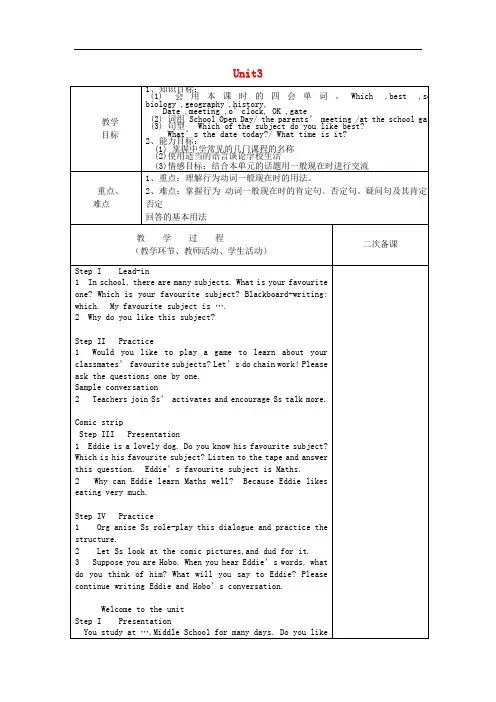
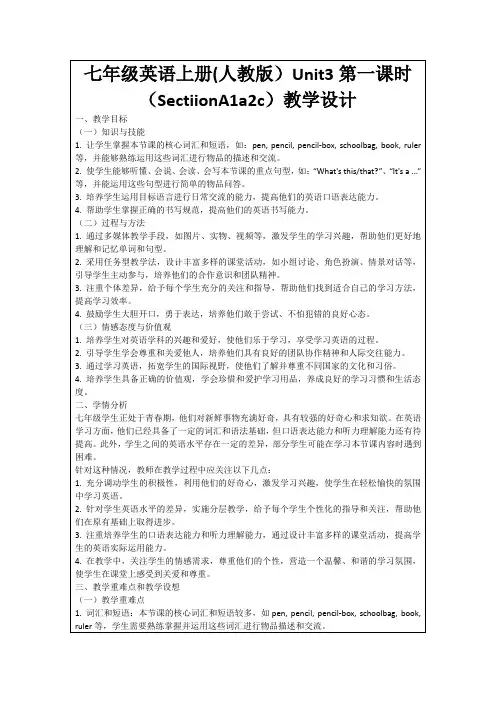
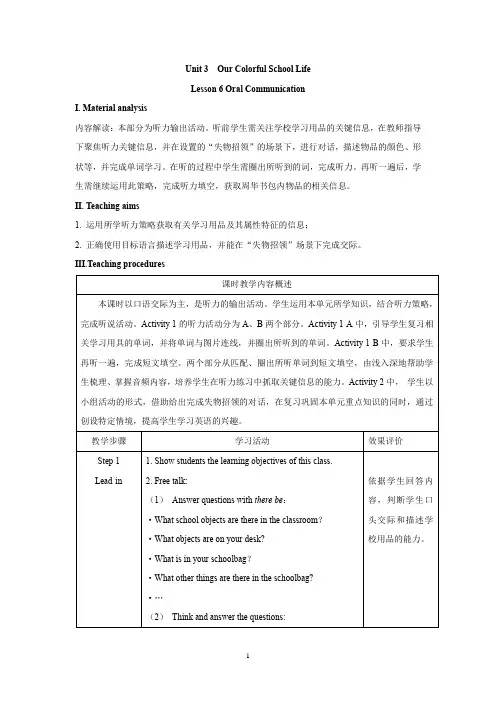
Unit 3 Our Colorful School Life
Lesson 6 Oral Communication
I. Material analysis
内容解读:本部分为听力输出活动。
听前学生需关注学校学习用品的关键信息,在教师指导下聚焦听力关键信息,并在设置的“失物招领”的场景下,进行对话,描述物品的颜色、形状等,并完成单词学习。
在听的过程中学生需圈出所听到的词,完成听力。
再听一遍后,学生需继续运用此策略,完成听力填空,获取周华书包内物品的相关信息。
II. Teaching aims
1. 运用所学听力策略获取有关学习用品及其属性特征的信息;
2. 正确使用目标语言描述学习用品,并能在“失物招领”场景下完成交际。
III.Teaching procedures
IV. Blackboard design。
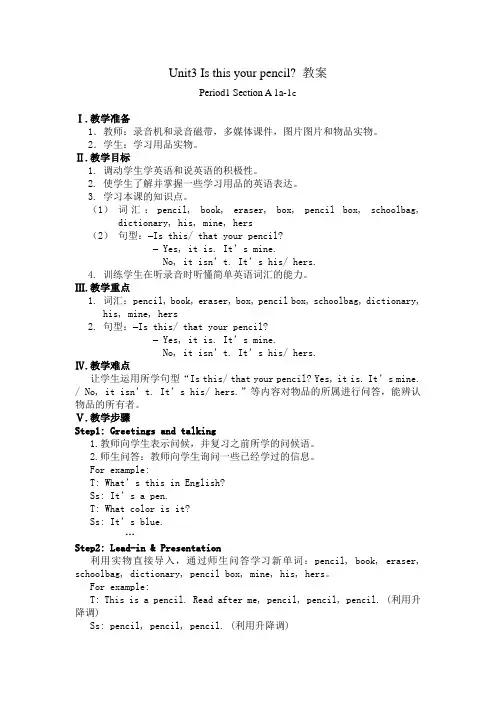
Unit3 Is this your pencil? 教案Period1 Section A 1a-1cⅠ.教学准备1.教师:录音机和录音磁带,多媒体课件,图片图片和物品实物。
2.学生:学习用品实物。
Ⅱ.教学目标1.调动学生学英语和说英语的积极性。
2.使学生了解并掌握一些学习用品的英语表达。
3.学习本课的知识点。
(1)词汇:pencil, book, eraser, box, pencil box, schoolbag, dictionary, his, mine, hers(2)句型:–Is this/ that your pencil?– Yes, it is. It’s mine.No, it isn’t. It’s his/ hers.4. 训练学生在听录音时听懂简单英语词汇的能力。
Ⅲ.教学重点1.词汇:pencil, book, eraser, box, pencil box, schoolbag, dictionary,his, mine, hers2.句型:–Is this/ that your pencil?– Yes, it is. It’s mine.No, it isn’t. It’s his/ hers.Ⅳ.教学难点让学生运用所学句型“Is this/ that your pencil? Yes, it is. It’s mine. / No, it isn’t. It’s his/ hers.”等内容对物品的所属进行问答,能辨认物品的所有者。
Ⅴ.教学步骤Step1: Greetings and talking1.教师向学生表示问候,并复习之前所学的问候语。
2.师生问答:教师向学生询问一些已经学过的信息。
For example:T: What’s this in English?Ss: It’s a pen.T: What color is it?Ss: It’s blue.…Step2: Lead-in & Presentation利用实物直接导入,通过师生问答学习新单词:pencil, book, eraser, schoolbag, dictionary, pencil box, mine, his, hers。
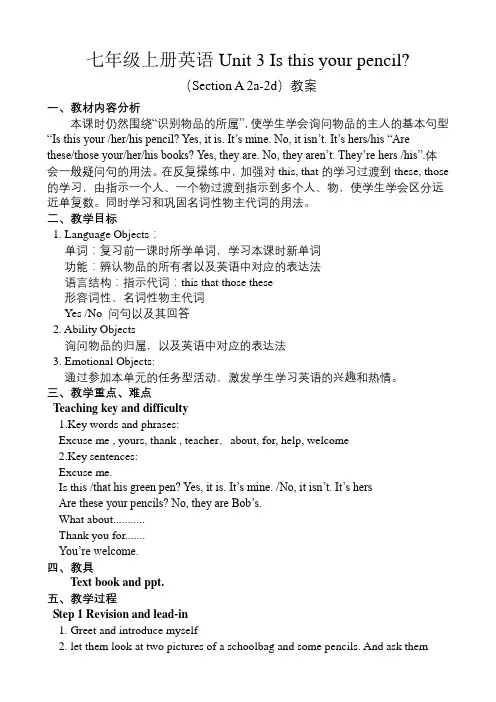
七年级上册英语Unit 3 Is this your pencil?(Section A 2a-2d)教案一、教材内容分析本课时仍然围绕“识别物品的所属”,使学生学会询问物品的主人的基本句型“Is this your /her/his pencil? Yes, it is. It’s mine. No, it isn’t. It’s hers/his “Are these/those your/her/his books? Yes, they are. No, they aren’t. They’re hers /his”.体会一般疑问句的用法。
在反复操练中,加强对this, that的学习过渡到these, those 的学习,由指示一个人、一个物过渡到指示到多个人、物,使学生学会区分远近单复数。
同时学习和巩固名词性物主代词的用法。
二、教学目标1. Language Objects:单词:复习前一课时所学单词,学习本课时新单词功能:辨认物品的所有者以及英语中对应的表达法语言结构:指示代词:this that those these形容词性、名词性物主代词Yes /No 问句以及其回答2. Ability Objects询问物品的归属,以及英语中对应的表达法3. Emotional Objects:通过参加本单元的任务型活动,激发学生学习英语的兴趣和热情。
三、教学重点、难点Teaching key and difficulty1.Key words and phrases:Excuse me , yours, thank , teacher,about, for, help, welcome2.Key sentences:Excuse me.Is thi s /that his green pen? Yes, it is. It’s mine. /No, it isn’t. It’s hersAre these your pencils? No, they are Bob’s.What about...........Thank you for.......You’re welcome.四、教具Text book and ppt.五、教学过程Step 1 Revision and lead-in1. Greet and introduce myself2. let them look at two pictures of a schoolbag and some pencils. And ask themquestions like:(1) A: What’s this /that? B: It’s a /an.......A: How do you spell it? B: ..........A: What color is it? B: It’s ........A: Is this your...? B: Yes, it is. It’s mine./No, it isn’t. It’s his/hers.(2) A: What’re these /those? B: They’re.......A: How do you spell it? B: ..........A: What color are they? B: They’re........A: Are these/those your......?B: Yes, they are. They are mine. /No, they aren’t. They’re his/hers3. Then give students a few minutes to make the similar conversations, and choose two or three pairs to act them out.Step 2 Listen1. Ask the names of the things in 2a like: what’s this/that? Or what’re these/those? Then play the radio, let them finish 2a and check the answers.2. Before listening, let them to pay attention to erasers and books, guess where they may be. Then listen 、finish and check the answers.3. Teach students to read the conversation, and explain the new phrase ---Excuse me4. Give students enough time to practice the conversation and make the similar conversations5.Invite some pairs to act their own conversations out.Step3 Task-reading 2d1.Give students some questions before reading 2d(1) 找出对话中形容词性物主代词、名词性物主代词和名词所有格。
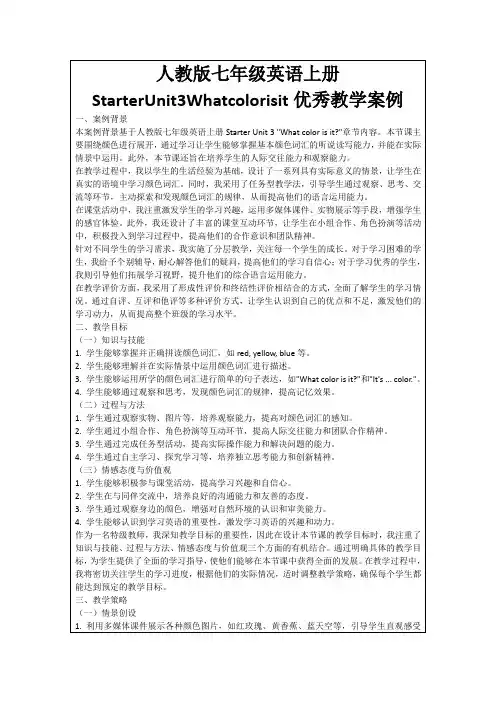
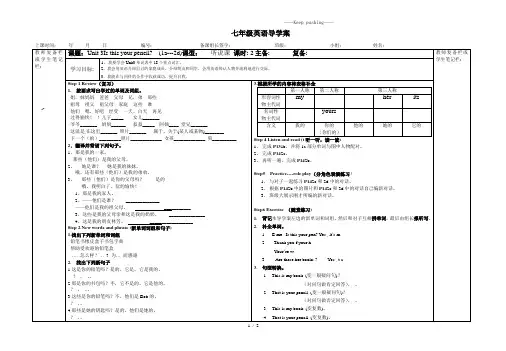
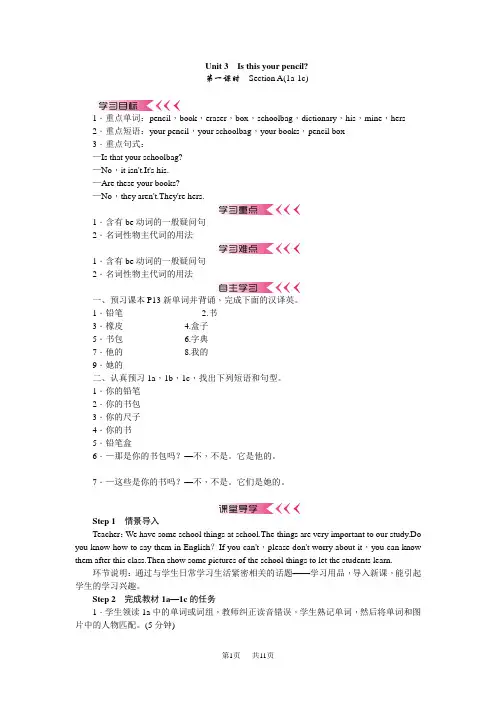
Unit 3Is this your pencil?第一课时Section A(1a-1c)1.重点单词:pencil,book,eraser,box,schoolbag,dictionary,his,mine,hers 2.重点短语:your pencil,your schoolbag,your books,pencil box3.重点句式:—Is that your schoolbag?—No,it isn't.It's his.—Are these your books?—No,they aren't.They're hers.1.含有be动词的一般疑问句2.名词性物主代词的用法1.含有be动词的一般疑问句2.名词性物主代词的用法一、预习课本P13新单词并背诵,完成下面的汉译英。
1.铅笔____________ 2.书____________3.橡皮____________ 4.盒子____________5.书包____________ 6.字典____________7.他的____________ 8.我的____________9.她的____________二、认真预习1a,1b,1c,找出下列短语和句型。
1.你的铅笔________________2.你的书包________________3.你的尺子________________4.你的书________________5.铅笔盒________________6.—那是你的书包吗?—不,不是。
它是他的。
________________________________________________________________________ 7.—这些是你的书吗?—不,不是。
它们是她的。
________________________________________________________________________Step 1情景导入Teacher:We have some school things at school.The things are very important to our study.Do you know how to say them in English?If you can't,please don't worry about it,you can know them after this class.Then show some pictures of the school things to let the students learn.环节说明:通过与学生日常学习生活紧密相关的话题——学习用品,导入新课,能引起学生的学习兴趣。
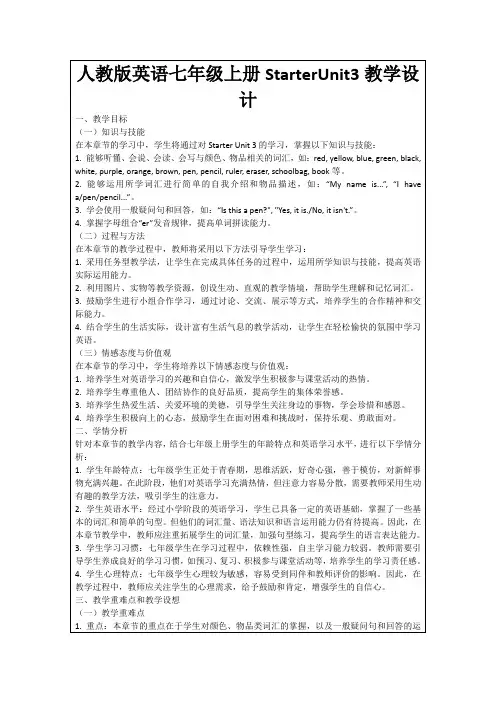
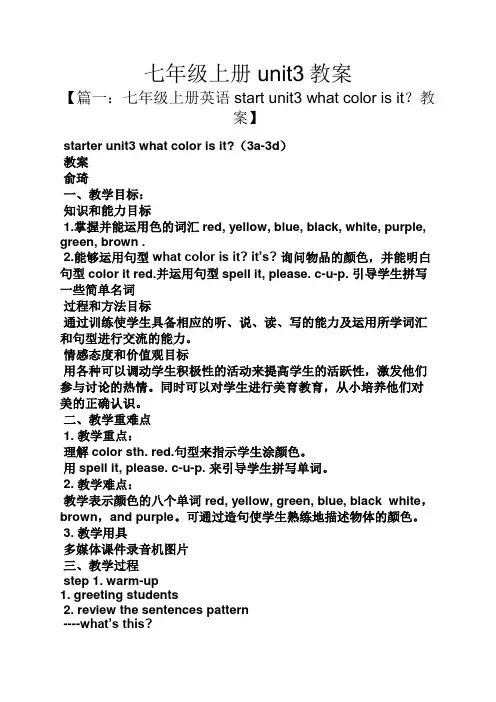
七年级上册unit3教案【篇一:七年级上册英语start unit3 what color is it?教案】starter unit3 what color is it?(3a-3d)教案俞琦一、教学目标:知识和能力目标1.掌握并能运用色的词汇red, yellow, blue, black, white, purple, green, brown .2.能够运用句型what color is it? it’s? 询问物品的颜色,并能明白句型color it red.并运用句型spell it, please. c-u-p. 引导学生拼写一些简单名词过程和方法目标通过训练使学生具备相应的听、说、读、写的能力及运用所学词汇和句型进行交流的能力。
情感态度和价值观目标用各种可以调动学生积极性的活动来提高学生的活跃性,激发他们参与讨论的热情。
同时可以对学生进行美育教育,从小培养他们对美的正确认识。
二、教学重难点1. 教学重点:理解color sth. red.句型来指示学生涂颜色。
用spell it, please. c-u-p. 来引导学生拼写单词。
2. 教学难点:教学表示颜色的八个单词 red, yellow, green, blue, black white,brown,and purple。
可通过造句使学生熟练地描述物体的颜色。
3. 教学用具多媒体课件录音机图片三、教学过程step 1. warm-up1. greeting students2. review the sentences pattern----what’s this?----it’s a cup.----what color is it?----it’s yellow.step 2. lead-in1. the teacher shows the colorful letters to lead in new lessons.2. write down the conversations.----what’s this?----it’s a cup.----what color is it?----it’s yellow.step 3. presentation1. introduce the sentences pattern “color sth. red.” and call students to use the sentence pattern to make sentences.2. activity 3a,listen and color the things.3. activity 3b, listen again, complete the sentences.4. activity 3c, listen and complete the chart.step 4. pair work1. use the things around us to make a conversation in the group.(2 minutes).2. then, call some groups to show it.3. copy the chart to show the things student s’ used in the conversations.step 5. presentation1. introduce the sentences pattern.----spell it, please.----c-u-p.2. practice the sentence pattern.step 6. group work----what’s this?----it’s a cup.----spell it, please.----c-u-p.----what color is it?----it’s yellow.step 7. 课外知识延伸:the meaning of the colors.不同的颜色在中西方文化中有不同的意义,学生了解下颜色的文化差异,拓宽知识面。
七年级上册英语unit3教案教案标题:七年级上册英语Unit 3教案教学目标:1. 学生能够掌握并正确使用有关家庭成员的英语词汇。
2. 学生能够用英语描述家庭成员的外貌特征和性格特点。
3. 学生能够运用所学知识进行口头和书面表达。
教学重点:1. 家庭成员的英语词汇。
2. 描述家庭成员的外貌特征和性格特点的句型。
3. 口头和书面表达。
教学难点:1. 描述家庭成员的外貌特征和性格特点的句型的运用。
2. 运用所学知识进行口头和书面表达。
教学准备:1. 多媒体设备。
2. 单词卡片和图片。
3. 板书工具。
教学过程:Step 1: 导入新课 (5分钟)1. 通过展示一些家庭成员的图片,引导学生讨论家庭成员的英语词汇。
2. 帮助学生学习和记忆家庭成员的英语词汇,使用单词卡片和图片进行互动。
Step 2: 学习新知 (15分钟)1. 播放一段关于家庭成员的短视频或录音,让学生通过听力理解来学习家庭成员的外貌特征和性格特点的表达方式。
2. 教授家庭成员的外貌特征和性格特点的句型,并帮助学生理解和掌握这些句型的用法。
3. 进行一些语言操练活动,如师生问答、小组讨论等,以巩固学生对句型的理解和运用能力。
Step 3: 拓展应用 (20分钟)1. 给学生一些家庭成员的图片,要求他们用英语描述这些家庭成员的外貌特征和性格特点。
2. 学生之间进行小组交流,分享他们所描述的家庭成员,并相互提出问题。
3. 引导学生用所学句型写一篇关于自己家庭成员的短文,并鼓励他们在短文中使用不同的句型和词汇。
Step 4: 巩固练习 (10分钟)1. 给学生一些练习题,让他们运用所学知识完成,如填空题、选择题等。
2. 教师检查学生的答案,并给予相应的指导和反馈。
Step 5: 总结和评价 (5分钟)1. 教师总结本节课的重点内容,并与学生一起复习所学知识。
2. 对学生的表现进行评价,鼓励他们在口头和书面表达中更加自信和流利。
Step 6: 作业布置 (5分钟)1. 布置家庭成员的英语词汇和句型的书面练习作业。
UNIT 3 THIS IS MY SISTER(the 1st period Section A 1a-1c, 2b-2d)Teaching aims: (教学目标)1. 学会表述家人的称谓, 区分家人的称谓..2. 学会介绍家人.3. 学会用疑问句来询问家人的称谓.Language points: (语言点)1. 要求掌握以下句式: (1) ------This is my …------ The se are my …------ This is his / her …------ These are his / her …------Is this your…?------ Are these your…?------ Is this his / her …?------ Are those his / her…?2. 要求掌握以下词汇: (1) 名词: sister, mother, father, parent, brother,grandmother, grandfather, friend, grandparent(2) 代词: these those3. 需要了解的节日:Family Day--- It’s a festival in th e USA. A national effort to promote parentalengagement as a simple, effective way to reduce youth substance abuse and raise healthier children.It’s always on the last weekend in September.Difficulties (难点) : 本课的难点是学生要区分和掌握家人的称谓, 而学生在初次接触的时候, 要分清楚各个称谓会有一定难度。
学生学习用一般疑问句来询问并回答家庭成员的关系也有一定的难度。
教学设计说明1. 最基本的英语打招呼练习, 复习前两单元的句型. 即是一个对所学知识的回顾,也是正式上课之前的热身。
Teaching steps (教学步骤)1. Warming-up and revision (课堂热身和复习)(1) Daily greetings to the students¹ (日常问候)T: Hello, what is you name?S: My name is ….T: Nice to meet you!S: Nice to meet you, too!(2) Revision (复习)T: What’s this in English?2S: This is / It is a pencil.T: How do you spell “pencil”?2.这个句型的练习也是对上个单元内容的复习。
复习This /That is …. 句型为新课学习做好铺垫。
3.借着上面复习到的句型,拿出准备好的照片,来引入接下来family的话题。
4.分别指向相应的人物,来介绍。
可在课前在黑板上写好相应的词汇,在自己介绍完之后,可要求学生跟着自己念,并及时纠正学生可能存在的发音错误。
5.拿出另外一张父亲单独的照片,来询问学生,并适时让他们分清楚parent 单复数的区别。
6.之后一些家庭成员词汇的教授,都要求学生大声地重复,以确保他们发音的正确。
7.这里需要适当解释和示范什么是 match。
在学生做练习的时候可以在教室中走动,来回指导一下。
S: P-E-N-C-I-L, pencil.T: Thank you.T: Wh at’s this /that in English?S: This/That is a pen / book / eraser / ruler / dictionary / backpack /Baseball / watch / key / computer game / notebook / ringT: How do you spell ---?S: ---2. Presentation (呈现新知识):T: What’s this in English?S: It’s a picture /photo.3T: Yes, this is a picture of my family.T: Can you see the woman?This is my mother4. Read after me, mother.S: Mother.T: Do you know which one is my father?This is my father4. Do you think he is handsome? Pleaseread after me, father.S: Father.T: If we want to call our father and mother together, we cancall them parents.T: Father is my parent,5 Mother is my parent, too. They aremy parents.T: Now look at these two old people. They are myGrandparents6. One is my grandfather, the other one ismy grandmother. They are old but they are healthy.T: I’m the only child in my family, so I don’t have anybrother or sister. But I have an uncle and an aunt. Theyare my father’s brother and sister. Look, they are here.3. Work on 1a: (完成P13—1a)T: Now, please open you books, and turn to page 13. lookat part 1a. You can see a picture of Dave’s familyand some words we have learned just now. Please matchthe words with the people in the picture.7…Check the answer.4. Drill (练习):T: Now, you are Dave8. Please cover the answer of 1a by8.让学生扮演Dave 的角色,让他们用第一人称来介绍家庭成员。
目的在于让学生能进一步熟悉新词汇。
9.此环节着重于听力的练习,当然,教师并不需要局限于磁带,可根据学生掌握情况,自己变化或添加听力内容。
此环节已经开始使用第三人称了。
10.接着上面的环节,让学生试着用第三人称介绍。
教师可以进行适当的讲解,也可以将句型写在黑板上。
11.这里加入了美国家庭日这个概念, 这样是便于给学生一个比较真实的环境,同时也是西方文化知识的补充。
教师除了介绍资料之外还可以问一下学生对此节日的想法。
using a piece of paper then listen to me carefully. I willgive you a letter, and you must tell me this letter meanswhich member in your family. For example, I say “c”.You should say “This is my mother”.Understand?T: OK, let’s begin. The first one is XX, your letter is “d”.S: These are my grandparents.T: Good job. Next one ---S: ---5. Work on 1b (完成 P13—1b)T: The next task is very easy for you. I will play the tape.Please listen carefully, and circle the people the boy talksabout in the picture9.T: Do you get the answer? Who does the boy talk about?S: His brothers and sister.T: You are so amazing.6. Work on 1c (完成P13—1c)T: I think everyone has known D ave’s family.Two students a group, please introduce Dave’s family10to each other. Please use “ This is his---.” “These are his---.”S1: This is his father.S2: These are his parents.S: ---7. Work on 2b (完成P14-2b)T: Today, I would like to introduce an American festivalto you, it is called “Family Day”11. On this day, the wholefamily get together, have meals and play games. Nowlook at the picture in 2b. These are Dave’s family members.They are having their “Family Day”. Look, they are sohap py.But I don’t know who are they exactly. Can you tellme?I will play the recording once more. And please matchthe name with the people in the picture.T: Can you give me your answer?S: ---…Presentation (呈现新知识)12.仍然是利用书上的图片,将本课新的句型进行呈现,并帮助学生在你问完问题后用Yes / No 来回答。